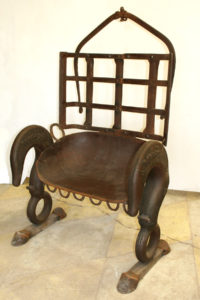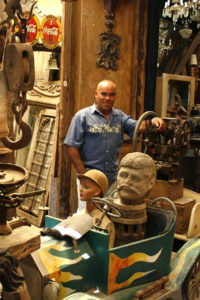Businessman Turned Sculptor Makes an Art of Recycling
As published in the Atención San Miguel newspaper —
Businessman Turned Sculptor Makes an Art of Recycling
Raul Reyna Viscaya is a master of reinvention, starting with himself. In 49 years, he’s gone from poverty on the rancho to entrepreneurial success in San Miguel, with many colorful stops along the way. Not one to rest on his laurels, he’s at it again. But this time, it’s art.
Reina’s many incarnations began in 1959, in Rancho Tres Palmas, about 25 kilometers Northeast of San Miguel. The youngest of 12 children, he grew up in a rambling old adobe house with 24 bedrooms and a huge mesquite tree in the courtyard. The Viscayas had once been wealthy—a long, long, long time ago. Reyna’s father inherited the century-old family home, its mysteries and rumors of buried treasure, and no money. Dad farmed and cared for livestock, while Mom ran the house and a tienda in one of the rooms. Their son, the last child left at home, helped them both.
Reyna’s education was homespun. “My mother would put me in front of a book and a notebook while she washed clothes,” he says. ‘Read me this, then write it out.’ She’d tell me. If I didn’t, I got a strong pinch.” His farmer father taught him his trade, the attendant skills, and then some. “Papá made his own plows out of mesquite,” he remembers. “Then others in the rancho had him make theirs.” Not surprisingly, Reyna grew to be quite a handy young man.
After his father’s death, nineteen-year-old Reyna convinced his mother to sell the rancho and move to San Miguel. They bought a small house on Relox and he set out to look for employment. The big city wasn’t kind to Reyna at first—nobody would hire him. To them, he says, he was just another kid from the Rancho, who didn’t know how to do anything useful. Out of desperation, he agreed to a plan of his sister’s, a nun at Las Monjas. She taught him another family skill and sent clients. For the next eight months, he did embroidery to support himself and his mother.
Finally, he found a job as a waiter. Not long after, more work came along at a nearby carpenter’s. No more embroidery! Reyna spent the next two years working literally night and day, saving as much money he could. “Some days, I‘d only get a couple of hours rest,” he recalls with a smile.
Reyna finally got to go to school when he was 24. “I’ve only come to learn to divide,” he warned Maestra Carmelita at the Escuela de Sollano. “And then, I’ll be leaving.” He needed division in order to progress as a carpenter, so he underwent a formal education…for a couple of weeks. Then he got back to work.
His many labors paid off when he was able to buy a small carpentry workshop and quit his jobs. He began making and restoring furniture. By now a confirmed workaholic, Reyna also started selling at markets around the area—used clothing, pens and pencils, anything and everything. “People started saying to me ‘Raul, you’re good at selling things,” he remembers. “‘I have a chair or a table,’ they’d say. ‘Will you sell it for me?’”
In 1982, Reyna heard that the Hotel Colonial on Canal (what is now the Plaza Colonial) was being remodeled. He tracked down the owner and bought all his vintage doors, on credit. Soon after, in the front room of Reyna’s house, San Miguel’s first used furniture bazaar, “La Puerta Vieja,” opened its (old) doors. Sensing a budding market, he kept buying beat-up doors, carrying them home on his bicycle. Soon, Reyna had five stores in town. He bought a truck and started driving all over the region, bringing back treasures to fix up and sell.
Fourteen years ago, he opened Casa Reyna on the road to Celaya. It’s hard to miss the barn-like emporium, festooned with objects from the beautiful to the bizarre—stone carvings, ancient doors, massive “Harleys,” strange cultural relics. Even Cinderella’s pumpkin carriage was once part of its everchanging display. In 2000, Reyna opened another roadside attraction—a second huge store on the highway to Queretaro.
His shops are a baroque blend of gallery, museum, yard sale, and grandma’s attic, whose eccentric abundance would make Gabriel Garcia Marquez blush. In Reynaland, boredom is not an option. Sensory overload, maybe, but never boredom. And we’re not just talking about the merchandise. Interspersed with antiques, bric-a-brac, and oddments, are Reyna’s offbeat displays of creativity (the fishing boat staircase at the main store, for example). And now there are the sculptures.
Reyna’s most recent obsession began with a case of buyer’s remorse. About three years ago, he bought the contents of a defunct silver mine, sight unseen. When a mountain of iron junk of dubious marketability (including 1,600 shovels, 160 wheelbarrows, a bunch of minecars, and scores of picks and chisels) was unloaded at his place, he got a bit nervous. “What am I going to do with all this stuff?” he wondered.
For the next year, question dogged him, regularly waking him up at night. (The elderly shovels weren’t exactly flying off the shelves.) Finally, an answer came. “I got this idea to make a shovel into a mask,” explains Reyna. “And then, I thought ‘hey, maybe I can make an animal.’”
This epiphany, however, lead not to more good nights’ sleep, but to fewer. Soon after, visions of a wheelbarrow ostrich woke Reyna at two a.m. and propelled him to his workshop. “My wife thought I was crazy.” He explains, “But I didn’t want to lose the idea.”
Inspiration now routinely hauls him out of bed, sending him to either notebook or studio. Mrs. Reyna is not as thrilled with this rampant creativity as her husband. “She is always mad at me now,” he says with a what-can-I-do? shrug. “Because I don’t let her get enough sleep.”

Baroque chair
Maybe he has gone a bit nuts. Or perhaps he’s a visionary. Either way, he’s turned a pile of dross into a body of work. His materials include discarded industrial equipment, dead mufflers, old rebar, junked tools, and worn-out horseshoes. The resulting sculptures are large and whimsical, yet grounded in attention to detail and affection for both animals and objects. Reyna’s reincarnations run the gamut from tractor dinosaurs to a meatgrinder chandelier (a personal favorite) to the myriad manifestations of the shovel. He’s created over 100 sculptures, the latest a life-size, three-dimensional rearing stallion made of 600 horse shoes, for his first show.
Raul Reyna, the gregarious man with the booming voice—the embroiderer, salesman, junk collector, antiquarian, carpenter, artist—has always enjoyed life. He’s just that kind of guy. But now, he’s really having fun. “If you find what you really love to do, you’ll be happy for the rest of your life,” he gushes, beaming. “I’ve been very lucky.”
Reyna’s art has transformed his life and his landscape. Ostrich now roam the grounds of Casa Reyna, and firewood-laden burros loiter in the shade. Pegasus forever strains for the sky, while titan motorcycles await their mythical riders. Dinosaurs keep silent vigil over his vast and quirky empire. And Reyna? Well, he keeps waking up his wife and turning trash into art.
Françoise Lemieux is a writer, photographer, and recovering thrift store junkie living in San Miguel de Allende, Mexico.
Text and photos By Françoise Lemieux






Leave a Reply
Want to join the discussion?Feel free to contribute!